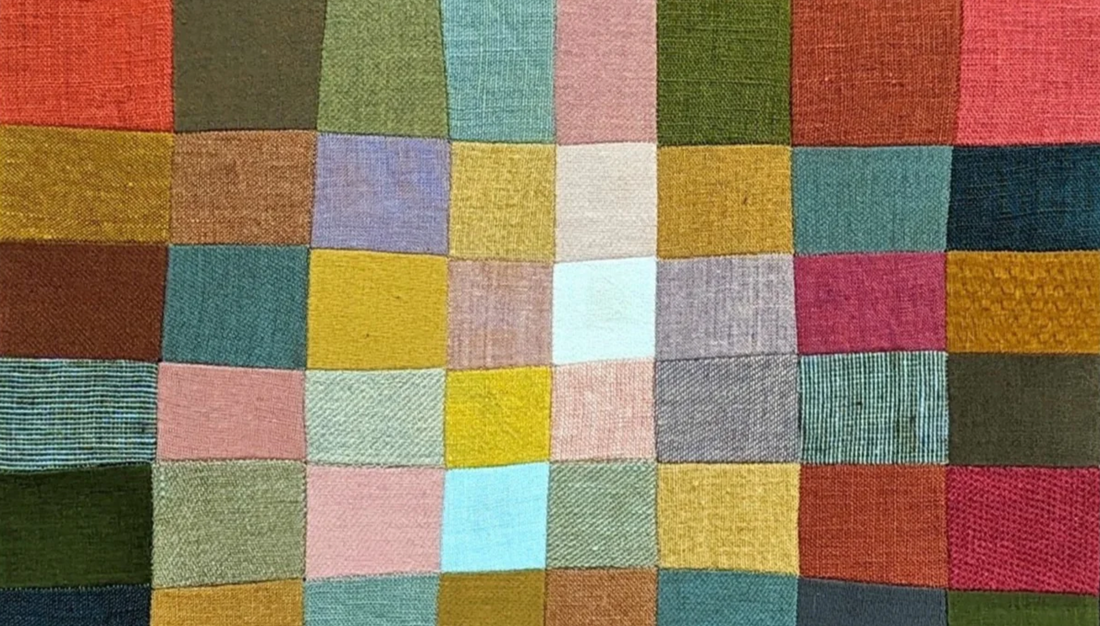
A YEAR OF QUILTING
Image courtesy of Catherine-Marie Longtin
Quilting is a process of sewing together pieces, as well as layers, of fabric, to create a padded, decorative textile. The top layer of a quilt is typically made up of small pieces of fabric that are sewn together in a pattern or design. The middle layer, called batting, provides the thickness and insulation, while the bottom layer is often a single piece of fabric. Historically quilting was done by hand and must have been painstaking process but its versatility and beauty is unrivalled. It made use of, as well, re-used textile fragments, that could be used to influence the shape of the pattern that it created.
English Paper Piecing
The craft of quilting has a rich history with a range of methods and traditions. English paper piecing is a quilting technique that involves using paper templates to sew together small fabric pieces, typically in geometric shapes such as hexagons, diamonds, or triangles. The paper templates are cut to the desired shape and size, and then used as a guide for sewing the fabric pieces together. To begin, a fabric piece is cut slightly larger than the paper template and then basted around the edges of the paper. The basting holds the fabric securely in place around the paper, and helps create the precise shape needed for the final quilt top. Image courtesy of Catherine-Marie Longtin
Image courtesy of Catherine-Marie Longtin
Once the fabric is basted around the paper template, multiple fabric pieces can be sewn together to create a larger design. Each piece is sewn to the adjacent piece using a small whip stitch, with the paper template providing a guide for the seam allowances and shape.
After the quilt top is complete, the paper templates are removed by gently pulling them out from the basting stitches. The resulting quilt top is typically very precise and geometrically accurate, and can be used to create a wide variety of quilt designs.
Catherine-Marie Longtin will be teaching a Freehand English Paper Piecing online workshop on
28 & Sunday 29 October 2023.
Bojagi
Typically square or rectangular, varying in size from a
small handkerchief to large pieces that can wrap up an entire table setting.
Bojagi have a long history in Korean culture, and were traditionally made by women as a way to repurpose scraps of fabric. The finished bojagi is a wrapping cloth, used for a variety of purposes such as wrapping gifts to carrying food, and are often decorated with intricate embroidery or patchwork designs.
Youngmin Lee is teaching a Bojagi online workshop on Wednesday 15 & Wednesday 29 November 2023.
Image courtesy of Youngmin Lee
Log cabin quilts
Log cabin quilts are a type of traditional patchwork quilt that feature strips of fabric arranged in a distinctive pattern that creates the appearance of a log cabin. Each block in a log cabin quilt is made up of a center square surrounded by strips of fabric, with each successive strip added in a clockwise or counterclockwise direction.
The center square in a log cabin quilt is typically red, to represent the hearth or the center of the cabin, while the surrounding strips of fabric can be any colour or pattern. The strips are usually sewn together using a technique called "foundation piecing," which involves sewing the fabric strips to a paper or muslin foundation to keep the edges straight and even.
Image courtesy of Sarah Gagnon
Log cabin quilts have a long history in American quilting, being thought to have originated with early American settlers, who used scraps of fabric to create warm quilts for their homes.
Sarah Gagnon from Pelican Quilts will be hosting a Log Cabin Hand Quilt online workshop on Saturday 30 September & Sunday 1 October 2023.
We hold online workshops throughout the year on a range of textile techniques. Whether you want to learn a new skill or develop an existing one, our workshops are aimed at a range of skillsets and objectives. Find out more about what we have on offer on our workshop page: www.selvedge.org/collections/workshops
